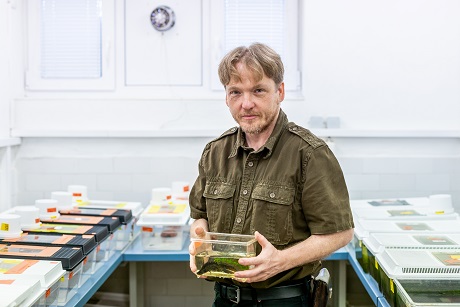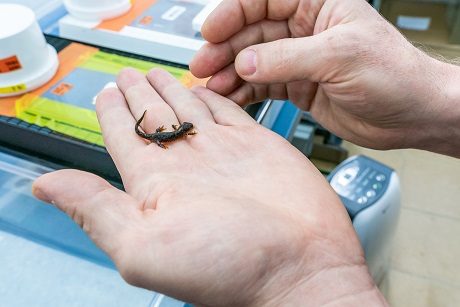Newts at War with Climate Change: They're Adapting to Survive the Threat of Extinction
Like with humans, some newts are capable of “burning” what they consume more quickly than others.
Like with humans, some newts are capable of “burning” what they consume more quickly than others. Individual variations in metabolic rate have now been confirmed by researchers at the Institute of Vertebrate Biology of the CAS, who found that those newts which burn calories faster are more active and more likely to find food and a mate. However, this advantage only holds true for environments that have enough resources. Moreover, it comes with certain downsides – for instance, a greater risk of detection by predators. The new research findings were published in the scientific journal Frontiers in Ecology and Evolution.
The smooth newt, the alpine newt, the common toad: up until a few decades ago, commonplace inhabitants of Czech forests, rivers, and pools, even in the proximity of cities. Today, their presence is becoming increasingly rare, and the question is how well these animals will manage to adapt to global climate change. Their adaptability has long been studied by Lumír Gvoždík’s team at the Institute of Vertebrate Biology of the CAS in the town of Studenec (Vysočina region).
The fat will be thin, the thin will be cold
One of the key amphibian traits that researchers focus on is the so-called standard metabolic rate. This fundamentally affects the ability of amphibians to survive under certain conditions and reproduce successfully. One method used to determine metabolic rate is called respirometry. It monitors the oxygen consumption of both animals intaking oxygen from the air (adult newts) and organisms in stages during which they absorb oxygen from water (aquatic larvae). The data collected is further analysed and compared by experts.
“Using modern statistical methods, we were able to prove that in a population of newts, those specimen with a faster metabolism are more active, while those with a slower metabolism are less active, thus finally confirming one of the basic hypotheses of how the organism manages its energy,” Lumír Gvoždík, the leader of the group, comments on the findings of the unique research.
However, whenever there are few food sources to be found in the environment, a slower metabolism, one that conserves energy, offers the better advantage. Thus, as Gvoždík recalls the old saying, “the fat will be thin, the thin will be cold”.

Lumír Gvoždík in the laboratory of the Institute of Vertebrate Biology of the CAS in the town of Studenec, Vysočina Region (CC)
Repeated experiments
Researchers measured the resting metabolic rate and movement activity in 62 juvenile (eft) alpine newts a total of four times, always twice at two different temperatures: at 12 °C and 22 °C. It is precisely the temperature of the environment which is very important for cold-blooded animals, largely influencing their metabolism and behaviour. “We obtained almost five hundred measurements, which represents a completely unique dataset,” explains Senka Baškiera, a PhD student involved in the research.
“Repeated measurements at the two temperatures proved to be crucial for this study to be a success, as we were the first to discover that body temperature affects the proportion of repeatable variability in an individual differently for each trait,” Gvoždík adds. It was only possible to determine the relationship between metabolism and movement activity once the results from both temperatures were analysed together.
Adapt or perish
Faced with climate change, amphibians (and not just them) have basically three options: adapt, relocate, or die out. However, animal migration is becoming increasingly difficult as the landscape becomes more obstructed by roads and motorways, industrial zones, and pesticide-treated monoculture crops. So, if amphibians are to avoid extinction, they must adapt.

Researchers are studying adult and juvenile newts. (CC)
Individual variation in animal populations is an important but still understudied strategy that helps cold-blooded animals cope with unpredictable changes in environmental conditions. The study of variation is of great importance in all fields of research that examine the issue of flexible traits at the level of the organism as a whole (e.g., physiology, ethology, ecology). For many physiological and behavioural traits, the differences are surprisingly small, and most of the value of the measured traits is the result of the immediate effect of various environmental factors. Overlooking them can therefore easily lead to misleading conclusions.
“Individual variation, i.e., differences among individuals within an animal population, in metabolic and behavioural traits may reduce the probability of population extinction when facing unpredictable changes in environmental conditions. It is important to conduct further research in this area to understand the impact of climate change on animal populations of not only newts, but also other cold-blooded species,” Gvoždík concludes.
The life (semi)aquatic
In Studenec, researchers are studying the ways in which newts adapt to changing conditions in labs inhabited by dozens of newt specimen. One of the rooms has a row of aquarium tanks containing water and plants, while the other row consists of terrariums. The newts live in water during mating and the egg and embryo stages, while the dry land terrariums house juvenile and adult newts.
The researched newts are handled with care. “We don’t kill the newts or interfere with their integrity, which is an important condition for research of legally protected species,” Gvoždík explains.
Prepared by: Leona Matušková, Division of External Relations of the CAO of the CAS
Photo: Jana Plavec, Division of External Relations of the CAO of the CAS; banner photo: Shutterstock
 Texts and photographs labelled (CC) are released for use under the Creative Commons license.
Texts and photographs labelled (CC) are released for use under the Creative Commons license.
Publication: Senka Baškiera, et al., Individual Variation in Thermal Reaction Norms Reveals Metabolic-Behavioral Relationships in an Ectotherm, frontiers in Ecology and Evolution (2022). DOI: 10.3389/fevo.2022.850941.
Original Story Source: Czech Academy of Sciences

 Alerts Sign-up
Alerts Sign-up